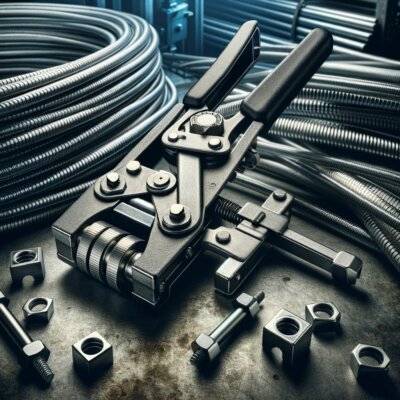Are you interested in learning what is a cable tie tensioning tool? In this guide, we'll explore their function, importance, and use.
Cable tie tensioning tools, also called tie guns or tensioners, aid users in swiftly tightening and trimming ties. Industries like manufacturing, construction, and electrical work widely use them for bundling cables. These tools typically allow users to adjust tie tension and cleanly trim excess.
Understanding the Functionality of Cable Tie Tensioning Tool
Using a cable tie tensioning tool is simple. Users insert the tie's loose end through the tool's tensioning mechanism. Next, they pull the tie until it reaches the desired tension level. Once properly tensioned, they utilize the tool's cutting mechanism to trim the excess tie, resulting in a tidy bundle. Certain tools may offer adjustable tension settings or ergonomic handles for added comfort and control.
Best Uses for Cable Tie Tensioning Tools

Wondering how to make the most out of your cable tie tensioning tool? Here are some of the best ways to utilize this essential tool for cable management:
1. Cable Organization
One of the primary uses of cable tie tensioning tools is for organizing cables and wires. Whether you're working in an office setting, a data center, or a home workshop, cable tie tensioning tools make it easy to bundle and secure cables neatly and securely. This helps prevent tangling, tripping hazards, and clutter, resulting in a safer and more organized environment.
2. Electrical Work
In electrical work, cable tie tensioning tools are crucial for organizing and securing cables to prevent interference and ensure safety. These tools bundle and secure cables in junction boxes and control panels, maintaining proper cable management practices and reducing electrical hazards.
3. HVAC Installation
During HVAC installation, professionals utilize cable tie tensioning tools to secure ductwork, piping, and components. Proper cable management ensures efficient airflow and system performance, achieved by securely fastening cables with these tools, resulting in a cleaner installation.
4. Automotive Applications
In automotive applications, professionals widely utilize cable tie tensioning tools to secure cables, wires, hoses, and tubing in vehicles. Cable tie tensioning tools simplify the bundling and securing of components, ensuring they remain in place, even in demanding conditions. This active involvement helps prevent damage, minimizes vibration, and enhances overall vehicle performance.
5. Construction and Manufacturing
Professionals in construction and manufacturing utilize cable tie tensioning tools to secure cables and wires in buildings and bundle components on assembly lines. These tools streamline workflow, improve efficiency, and maintain organized workspaces, resulting in faster production and higher-quality products.
Wrapping Up
Using a cable tie tensioning tool offers several benefits over manually tightening and trimming cable ties. First and foremost, it saves time and effort, allowing users to complete cable management tasks more quickly and efficiently.
Additionally, cable tie tensioning tools ensure a consistent level of tension across all ties, resulting in a more secure and professional-looking installation. Finally, these tools help reduce the risk of hand fatigue and repetitive strain injuries associated with manual cable tie installation, making them a valuable addition to any toolkit.

